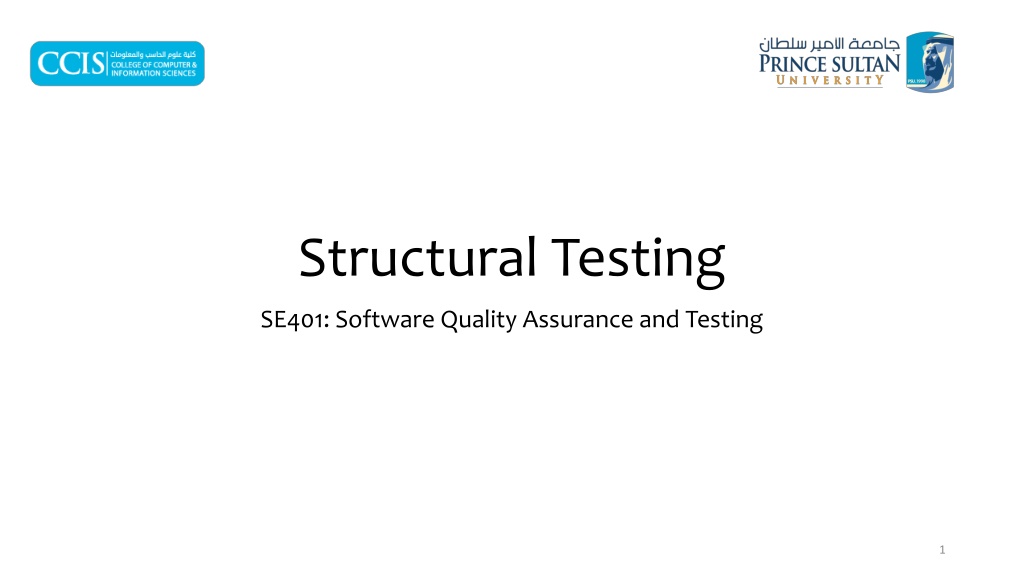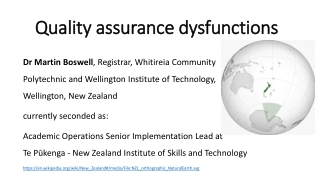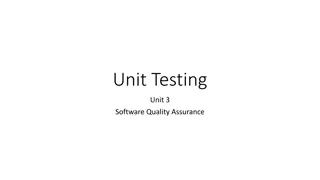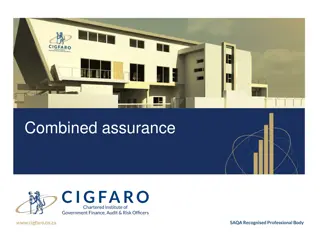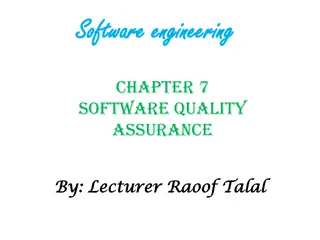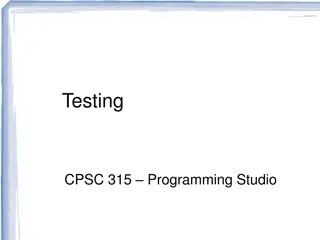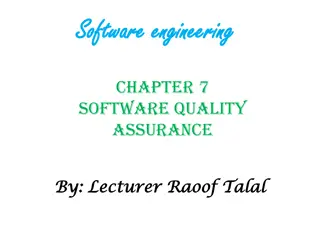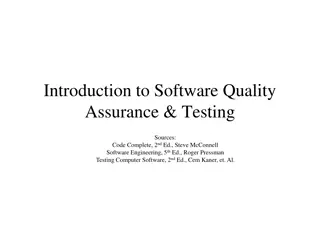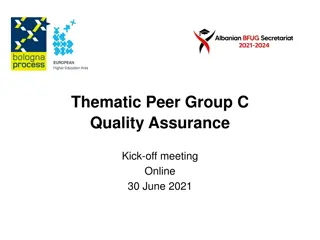Exploring Structural Testing in Software Quality Assurance: Airbus A320 Case Study
Delve into the world of structural testing through a detailed case study on the Airbus A320 program. Explore models, control flow coverage, path testing, and Java code coverage tools, along with insights into fatal accidents, causes, and program graphs. Uncover the complexities of the fly-by-wire system and its implications on software quality and testing practices.
Download Presentation

Please find below an Image/Link to download the presentation.
The content on the website is provided AS IS for your information and personal use only. It may not be sold, licensed, or shared on other websites without obtaining consent from the author. Download presentation by click this link. If you encounter any issues during the download, it is possible that the publisher has removed the file from their server.
E N D
Presentation Transcript
Structural Testing SE401: Software Quality Assurance and Testing 1
Outline Case Study - Airbus A320 Program Models and Graphs White Box (Structural) Testing Control Flow Coverage Beyond Branch and Condition Testing Path Testing Cyclomatic Complexity Java Code Coverage Tools Summary 2
Case Study Airbus A320 Launched in 1984 First civilian fly-by-wire computer system so advanced it can land plane virtually unassisted No instrument dials 6 CRTs 4
Case Study Airbus A320 Fatal Accidents Air France Flight 296 Alsace, France, June 26, 1988 The airplane software interpreted the low altitude/downed gear as "We're about to land Would not allow the pilot to control the throttle. 3 people died, 133 survived Indian Airline Flight 605 Bangalore, India, February 14, 1990 92 people died, 56 survived Air Inter Flight 148 video Mont Sainte Odile, January 20, 1992 87 people died, 9 survived 5
Case Study Airbus A320: What Were the Causes? The fly-by-wire system could ignore pilot actions. Warning system alerts only seconds before accident. no time to react Programmed landing maneuvers with bug in altitude calculation Altimeter showed the plane was higher than its actual altitude Flight path angle and vertical speed indicator have the same display format confuses pilots Note: In vertical speed mode "-3.3" means a descent rate of 3300 feet/min. In TRK/FPA (track/flight path angle) mode this would have meant a (correct) -3.3 deg descent angle. 6
Properties of Models Compact: representation of a system Predictive: represent some salient characteristics well enough to distinguish between good and bad no single model represents all characteristics Semantically meaningful: permits diagnosis of the causes of failure Sufficiently general: general enough for practical use 8
Graph Representations: directed graphs Directed graph: N (set of nodes) E (relation on the set of nodes ) edges Nodes: {a, b, c} Edges: {(a,b), (a, c), (c, a)} a b a c b c 9
Graph Representations: labels and code We can label nodes with the names or descriptions of the entities they represent. If nodes a and b represent program regions containing assignment statements, we might draw the two nodes and an edge (a,b) connecting them in this way: x = y + z; a = f(x); 10
Multidimensional Graph Representations Sometimes we draw a single diagram to represent more than one directed graph, drawing the shared nodes only once class B extends (is a subclass of) class A class B has a field that is an object of type C extends relation NODES = {A, B, C} EDGES = {(A,B)} a includes relation NODES = {A, B, C} EDGES = {(B,C)} b c 11
Example of Control Flow Graph public static String collapseNewlines(String argStr) public static String collapseNewlines(String argStr) { char last = argStr.charAt(0); StringBuffer argBuf = new StringBuffer(); { char last = argStr.charAt(0); StringBuffer argBuf = new StringBuffer(); b2 for (int cIdx = 0 ; cIdx < argStr.length(); b3 for (int cIdx = 0 ; cIdx < argStr.length(); cIdx++) { char ch = argStr.charAt(cIdx); if (ch != '\n' || last != '\n') { argBuf.append(ch); last = ch; } } False True b4 { char ch = argStr.charAt(cIdx); if (ch != '\n' True False || last != '\n') b5 True { argBuf.append(ch); last = ch; } b6 False } b7 cIdx++) return argBuf.toString(); } b8 return argBuf.toString(); } 12
Flowchart Testers usually use flowcharts in the test plan, test strategy, requirements artifacts or other process documents. Here are two ways we testers use flow charts: Flowcharts for control flow and statistical analysis Flow charts for process illustration 13
Control Flow Graph (CFG) Intra-procedural control flow graph Nodes = regions of source code, basic blocks maximal program region with a single entry and single exit Statements are grouped in single block Single statement can also be broken into multiple nodes Directed edges = control flow program execution may proceed from one node to another 14
White Box Testing a.k.a. Structural Testing 15
Structural Testing Judging the thoroughness of a test suite based on the structure of the program Compare to functional (requirements based, black-box) testing Structural testing is still testing product functionality against its specification. Only the measure of thoroughness has changed. Usually done by the programmers as part of unit testing 16
Why Structural Testing? What is missing in our test suite? If part of a program is not executed by any test case in the suite, defects in that part cannot be exposed. What is a part ? Typically, a control flow element or combination: Statements (or CFG nodes), branches (or CFG edges) Fragments and combinations: conditions, paths Complements functional testing: Another way to recognize cases that are treated differently 17
Structural Testing Structural testing techniques serve two purposes: Test coverage measurement We can assess the amount of testing performed by tests derived from e.g. specification- based technique to asses coverage. Structural test case design We can generate additional test cases with the aim of increasing the test coverage. 18
What is coverage? ???????? =?????? ?? ???????? ????? ?????????? ????? ?????? ?? ???????? ????? 100 A coverage item is whatever we have been able to count and see whether a test has exercised or used this item. NB! 100% coverage does not mean that 100% tested! 19
Structural Coverage Testing Idea Code that has never been executed likely has bugs At least the test suite is clearly not complete This leads to the notion of code coverage Divide a program into elements (e.g., statements) Define the coverage of a test suite to be 20
Control Flow Graphs: The One Slide Tutorial X =3 X = 3; if (B >0) B >0 Y = 0; else Y = Z +W Y =0 Y = Z +W; A = 2 *3; A = 2 *3 A graph Nodes are basicblocks statements Edges are transfers of control between basic blocks 21
Test Adequacy Criterion Adequacy criterion of a test suite Whether a test suite satisfies some property deemed important to thoroughly test a program e.g., Cover all statements Cover all branches 22
Control Flow Based Adequacy Criteria and Coverage Statement coverage Cover every statement at least once Branch coverage, a.k.a. decision coverage Cover every branch at least once (Basic) Condition coverage Cover each outcome of every condition Branch-Condition coverage Cover all conditions and all branches Modified condition decision coverage (MC/DC) Compound condition coverage Cover all possible combinations of every condition 23
A Simple Example of Coverage if ( a < b and c == 5) { y++; } x = 5; Statement coverage: Test case (a) Branch coverage: Test cases (a) and (b) (Basic) Condition coverage: Test case (b) and (c) Problem: and (&&) short circuits! And second half of (c) not executed. Branch-Condition coverage: Test case (a) (b) and (c) Compound condition coverage: Test case (a) (b) (c) and (d) * and is interpreted as logical-and Test cases: (a) a < b, c == 5 (b) a < b, c != 5 (c) a >= b, c == 5 (d) a >= b, c != 5 24
Statement Testing Adequacy criterion: each statement (or node in the CFG) must be executed at least once Coverage: # executed statements # statements Rationale: A defect in a statement can only be revealed by executing the faulty statement 25
Statements or Blocks? Nodes in a CFG often represent basic blocks of multiple statements basic block coverage or node coverage difference in granularity, not in concept No essential difference 100% node coverage 100% statement coverage but levels will differ below 100% A test case that improves one will improve the other though not by the same amount, in general 26
Statement Coverage: Example Test requirements Nodes 3, , 9 Test cases (x = 20, y = 30) Any problemswith this example? 27
Statement Coverage: Example Test requirements Nodes 3, , 9 Test cases (x = 20, y = 30) Such test does not reveal the fault at statement 7 To reveal it, we need to traverse edge 4-7 => Branch Coverage 28
Statement Coverage in Practice Microsoft reports 80-90% statement coverage Boeing must get 100% statement coverage (feasible) for all software Usually can about 85% coverage; 100% is harder Unreachable code; dead code Complex sequences Not enough resources 29
Branch Testing Adequacy criterion: each branch (edge in the CFG) of every selection statement (if, switch) must be executed at least once Coverage: # executed branches # branches 30
Statements vs. Branches Traversing all edges of a graph causes all nodes to be visited Satisfying branch adequacy implying satisfying the statement adequacy The converse is not true A statement-adequate (or node-adequate) test suite may not be branch-adequate (edge-adequate) 31
Branch Coverage: Example Test requirements Edges 4-6, Edges 4-7 Test cases (x = 20, y = 30) (x = 0, y = 30) 32
Branch Coverage: Example 1. main(){ 2. 3. 4. 5. 6. 7. 8. 9. 10. 11. 12. int x, y, z, w; read(x); read(y); if (x != 0) z = x + 10; else z = 0; if (y>0) w = y / z; BranchCoverage Test Cases (x = 1, y = 22) (x = 0, y =-10) Is the test suite adequate for branch coverage? } 33
Branch Coverage: Example 1. main(){ 2. 3. 4. 5. 6. 7. 8. 9. 10. 11. 12. BranchCoverage int x, y, z, w; read(x); read(y); if (x != 0) z = x + 10; else z = 0; if (y>0) w = y / z; Test Cases (x = 1, y = 22) (x = 0, y =-10) Is the test suite adequate for branch coverage? Yes, but it does not reveal the fault at statement 10 Test case (x = 0, y = 22) } Reveals fault 34
Branch Coverage: Example Consider test cases {(x=5,y=5), (x=5, y=-5)} The test suite is adequate for branch coverage, but does not reveal the fault at statement 6 Predicate 4 can be true or false operating on only one condition Basic condition coverage 35
(Basic) Condition Testing Adequacy criterion: Both outcomes (true and false) of each basic condition or predicate, must be tested at least once Basic condition or predicate: a Boolean expression that does not contain other Boolean expression Coverage: # truth values taken by all basic conditions 2 * # basic conditions [See note] 36
Basic Condition Coverage: Example Consider test cases {(x=5,y=5), (x=5, y=-5)} The test suite is adequate for basic condition coverage, but it does not reveal the fault at statement 6 The test suite is not adequate for branch coverage. Branch and condition coverage 37
Branch-Condition Testing Branch and condition adequacy Cover all conditions and all branches Both outcomes (true and false) of each basic condition must be tested at least once. All branches of every selection statement must be executed at least once . Notice that due to the left-to-right evaluation order and short-circuit evaluation of logical OR expressions, the value true for the first condition does not need to be combined with both values false and true for the second condition. 38
Compound Condition Testing Compound (multiple) condition adequacy: Cover all possible combinations of compound conditions and cover all branches of a selection statement For a compound condition with n basic conditions, 2ntest cases may be needed. C1 T T F F C2 T F T F C T F F F C = C1 and C2 T1 T2 T3 T4 39
Compound Conditions: Exponential Complexity (((a || b) && c) || d) && e Test Case a b c d e (1) (2) (3) (4) (5) (6) (7) (8) (9) (10) (11) (12) (13) T F T F F T F T F F T F F T T F T T F T F T T F F T T F F F F T T T T T T F F F T T T T T F F F F F short-circuit evaluation often reduces this to a more manageable number, but not always 40
Modified Condition/Decision Coverage (MC/DC) Motivation: Effectively test important combinations of conditions, without exponential blowup in test suite size Important combinations means: each basic condition shown to independently affect the outcome of each decision Requires: For each basic condition C, two test cases, C evaluates to true for one and false for the other Values of all other evaluated conditions remain the same The compound condition as a whole evaluates to true for one and false for the other 41
Construct Test Cases for MC/DC MC/DC with two basic conditions C1 C2 C T1 T T T C = C1 && C2 T2 T F F T3 F T F C1 C2 C T1 T2 T3 T F F F T F T T F C = C1 || C2 42
Construct Test Cases for MC/DC MC/DC with three basic conditions C = (C1 && C2)&&C3 1. Copy rows T1, T2, T3 in the (C1 && C2) table to the table below and 2. Fill in true for column C3 C1 T T F C2 T F T C3 T T T C T F F T1 T2 T3 T4 Operator || can be handled similarly (symmetric) 43
Construct Test Cases for MC/DC MC/DC with three basic conditions C = (C1 && C2) && C3 3. Add a newrow for T4 Column C3: false Column C1 and C2: copy the values from one of T1, T2, or T3 with true outcome C1 T C2 T C3 T C T T1 T2 T F T F T3 F T T F T4 T T F F 44
MC/DC: Linear Complexity Only n+1 test cases needed for n basic conditions Adopted by many industry quality standards (((a || b) && c) || d) && e Test Case a b c d e Outcome (1) (2) (3) (6) (11) (13) true false true true true false -- true -- -- -- false true true false true false -- -- -- true -- false false true true true false -- -- true true true false false false Values in red independently affect the output of the decision 45
Analysis of MC/DC MC/DC is basic condition coverage (C) decision (branch) coverage (DC) plus one additional condition (M): every condition must independently affect the decision's outcome Subsumed by compound conditions Subsumes all other criteria discussed so far stronger than statement and branch coverage A good balance of thoroughness and test size therefore widely used 46
Leave (Almost) No Code Untested In general 90% coverage is achievable 95% coverage require significant effort 100% not always attainable Challenges in coverage Platform specific code Defensive programming Exception handling Non-public method, never invoked 47
Summary Rationale for structural testing Basic terms: adequacy, coverage Characteristics of common structural criteria Statement, branch, condition, compound condition, MC/DC Practical uses and limitations of structural testing 48
Path Testing 49
Paths Testing Beyond individual branches. Should we explore sequences of branches (paths) in the control flow? Many more paths than branches A pragmatic compromise will be needed 50
